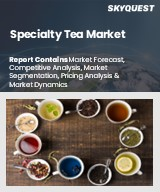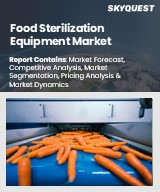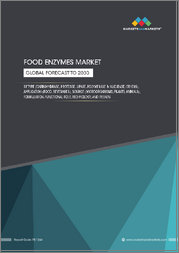
|
시장보고서
상품코드
1796473
스페셜티 차 시장 규모, 점유율, 성장 분석 : 유형별, 유통 채널별, 용도별, 지역별 - 산업 예측(2025-2032년)Specialty Tea Market Size, Share, and Growth Analysis, By Type (Herbal Tea, Green Tea), By Distribution Channel (Supermarkets/Hypermarkets, Specialty Stores), By Application, By Region - Industry Forecast 2025-2032 |
||||||
세계 스페셜티 차 시장 규모는 2023년에 60억 달러로 평가되었으며, 2024년 63억 6,000만 달러에서 2032년에는 101억 4,000만 달러로 성장하여 예측 기간(2025-2032년) 동안 CAGR 6.0%로 성장할 전망입니다.
세계 스페셜티 차 시장은 프리미엄급 고품질 옵션과 독특한 맛에 대한 소비자 선호도 변화에 힘입어 강력한 성장세를 보이고 있습니다. 가처분 소득이 증가함에 따라 전통적인 상품차에서 장인정신과 싱글 오리진 품종으로의 전환이 두드러지게 나타나고 있습니다. 허브차, 녹차 등 차의 종류와 관련된 건강 효과에 대한 인식이 높아짐에 따라 소비자들은 프리미엄, 건강, 체험형 음료에 대한 수요가 더욱 증가하고 있습니다. 카페 문화와 '제3의 물결' 커피 운동의 영향도 이 부문을 형성하고 있습니다. 그러나 기존 홍차에 비해 높은 가격대, 기후변화의 영향을 받기 쉬운 복잡한 공급망, 스페셜티 차에 대한 정의가 표준화되지 않은 점, 다른 프리미엄 음료 카테고리와의 경쟁 압력으로 인해 소비자 혼란을 야기하는 점 등의 과제도 남아있습니다.
목차
소개
- 조사 목적
- 조사 범위
- 정의
조사 방법
- 정보 조달
- 2차와 1차 데이터 방법
- 시장 규모 예측
- 시장 가정과 제한
주요 요약
- 세계 시장 전망
- 공급과 수요 동향 분석
- 부문별 기회 분석
시장 역학과 전망
- 시장 개요
- 시장 규모
- 시장 역학
- 성장 촉진요인과 기회
- 성장 억제요인과 과제
- Porters 분석
주요 시장 인사이트
- 핵심성공요인
- 경쟁 정도
- 주요 투자 기회
- 시장 생태계
- 시장 매력 지수(2024년)
- PESTEL 분석
- 거시경제 지표
- 밸류체인 분석
- 가격 분석
- 사례 연구
- 고객 구매 행동 분석
스페셜티 차 시장 규모 : 유형별 & CAGR(2025-2032년)
- 시장 개요
- 허브티
- 녹차
- 홍차
- 우롱차
- 백차
- 보이차
스페셜티 차 시장 규모 : 유통 채널별 & CAGR(2025-2032년)
- 시장 개요
- 슈퍼마켓/하이퍼마켓
- 전문점
- 온라인 소매
- 푸드서비스
스페셜티 차 시장 규모 : 용도별 & CAGR(2025-2032년)
- 시장 개요
- 주거용
- 상업용
- 호텔
- 레스토랑
- 카페
스페셜티 차 시장 규모 & CAGR(2025-2032년)
- 북미
- 미국
- 캐나다
- 유럽
- 독일
- 스페인
- 프랑스
- 영국
- 이탈리아
- 기타 유럽
- 아시아태평양
- 중국
- 인도
- 일본
- 한국
- 기타 아시아태평양
- 라틴아메리카
- 브라질
- 기타 라틴아메리카
- 중동 및 아프리카
- GCC 국가
- 남아프리카공화국
- 기타 중동 및 아프리카
경쟁 정보
- 상위 5개사의 비교
- 주요 기업의 시장 포지셔닝(2024년)
- 주요 시장 기업이 채용한 전략
- 최근의 시장 동향
- 기업의 시장 점유율 분석(2024년)
- 주요 기업 개요
- 기업 상세
- 제품 포트폴리오 분석
- 기업 부문별 점유율 분석
- 매출 전년비 비교(2022-2024년)
주요 기업 개요
- Unilever(T2, Pukka Herbs)(United Kingdom)
- Associated British Foods(Twinings)(United Kingdom)
- Tata Consumer Products(Teapigs)(India)
- Starbucks Corporation(Teavana)(United States)
- Harney & Sons(United States)
- DAVIDsTEA(Canada)
- The Republic of Tea(United States)
- R.C. Bigelow, Inc.(United States)
- Numi, Inc.(United States)
- Yogi Tea(United States)
- Kusmi Tea(France)
- Mariage Freres(France)
- Lupicia(Japan)
- Dilmah Ceylon Tea Company PLC(Sri Lanka)
- Vahdam Teas(India)
결론과 제안
KSM 25.09.03Global Specialty Tea Market size was valued at USD 6.0 billion in 2023 and is poised to grow from USD 6.36 billion in 2024 to USD 10.14 billion by 2032, growing at a CAGR of 6.0% during the forecast period (2025-2032).
The global specialty tea market is experiencing robust growth, propelled by a shift in consumer preferences towards premium, high-quality options and unique flavors. As disposable incomes rise, there is a noticeable transition from traditional commodity teas to artisanal and single-origin varieties. Increased awareness of the health benefits linked to tea types such as herbal and green varieties further drives demand, with consumers seeking premium, healthy, and experiential beverages. Influences from cafe culture and the "third wave" coffee movement are also shaping this segment. However, challenges persist, including higher price points compared to conventional tea, a complex supply chain vulnerable to climate change, and a lack of standardized definitions for specialty tea, leading to consumer confusion amid competitive pressures from other premium beverage categories.
Top-down and bottom-up approaches were used to estimate and validate the size of the Global Specialty Tea market and to estimate the size of various other dependent submarkets. The research methodology used to estimate the market size includes the following details: The key players in the market were identified through secondary research, and their market shares in the respective regions were determined through primary and secondary research. This entire procedure includes the study of the annual and financial reports of the top market players and extensive interviews for key insights from industry leaders such as CEOs, VPs, directors, and marketing executives. All percentage shares split, and breakdowns were determined using secondary sources and verified through Primary sources. All possible parameters that affect the markets covered in this research study have been accounted for, viewed in extensive detail, verified through primary research, and analyzed to get the final quantitative and qualitative data.
Global Specialty Tea Market Segments Analysis
Global Specialty Tea Market is segmented by Type, Distribution Channel, Application and region. Based on Type, the market is segmented into Herbal Tea, Green Tea, Black Tea, Oolong Tea, White Tea and Pu-erh Tea. Based on Distribution Channel, the market is segmented into Supermarkets/Hypermarkets, Specialty Stores, Online Retail and Foodservice. Based on Application, the market is segmented into Residential and Commercial. Based on region, the market is segmented into North America, Europe, Asia Pacific, Latin America and Middle East & Africa.
Driver of the Global Specialty Tea Market
The demand for beverages that provide health benefits is driving growth in the global specialty tea market. As consumers become more health-conscious, they are turning to specialty teas like green tea, renowned for its high antioxidant levels, as well as herbal teas known for their calming properties. This shift is largely influenced by the increasing focus on health and wellness, leading individuals to seek alternatives to sugary drinks. As a result, there is a growing preference for natural and healthier beverage options, further propelling interest in specialty teas within the global marketplace.
Restraints in the Global Specialty Tea Market
The Global Specialty Tea market faces a significant constraint due to the premium pricing of specialty teas compared to standard tea bags. This elevated cost can deter potential consumers, particularly in developing economies where affordability is a key concern. As a result, market adoption is limited, creating challenges for growth. Additionally, during periods of economic downturn when consumers are more likely to cut back on discretionary spending, the higher expense of specialty teas can further restrict their market appeal. This financial barrier may hinder the expansion and accessibility of specialty teas in various regions worldwide.
Market Trends of the Global Specialty Tea Market
The global specialty tea market is increasingly shaped by a focus on sustainability and ethical sourcing, reflecting a shift in consumer values. As awareness of environmental and social issues grows, brands are prioritizing certifications such as Fair Trade and organic credentials to appeal to discerning consumers. This commitment to transparency in the supply chain serves as a crucial differentiator, with consumers actively seeking products that align with their ethical convictions. Consequently, companies that effectively communicate their sustainability initiatives and responsible sourcing practices are gaining a competitive edge, driving innovation and growth in the specialty tea sector.
Table of Contents
Introduction
- Objectives of the Study
- Scope of the Report
- Definitions
Research Methodology
- Information Procurement
- Secondary & Primary Data Methods
- Market Size Estimation
- Market Assumptions & Limitations
Executive Summary
- Global Market Outlook
- Supply & Demand Trend Analysis
- Segmental Opportunity Analysis
Market Dynamics & Outlook
- Market Overview
- Market Size
- Market Dynamics
- Drivers & Opportunities
- Restraints & Challenges
- Porters Analysis
- Competitive rivalry
- Threat of substitute
- Bargaining power of buyers
- Threat of new entrants
- Bargaining power of suppliers
Key Market Insights
- Key Success Factors
- Degree of Competition
- Top Investment Pockets
- Market Ecosystem
- Market Attractiveness Index, 2024
- PESTEL Analysis
- Macro-Economic Indicators
- Value Chain Analysis
- Pricing Analysis
- Case Studies
- Customer Buying Behavior Analysis
Global Specialty Tea Market Size by Type & CAGR (2025-2032)
- Market Overview
- Herbal Tea
- Green Tea
- Black Tea
- Oolong Tea
- White Tea
- Pu-erh Tea
Global Specialty Tea Market Size by Distribution Channel & CAGR (2025-2032)
- Market Overview
- Supermarkets/Hypermarkets
- Specialty Stores
- Online Retail
- Foodservice
Global Specialty Tea Market Size by Application & CAGR (2025-2032)
- Market Overview
- Residential
- Commercial
- Hotels
- Restaurants
- Cafes
Global Specialty Tea Market Size & CAGR (2025-2032)
- North America (Type, Distribution Channel, Application)
- US
- Canada
- Europe (Type, Distribution Channel, Application)
- Germany
- Spain
- France
- UK
- Italy
- Rest of Europe
- Asia Pacific (Type, Distribution Channel, Application)
- China
- India
- Japan
- South Korea
- Rest of Asia-Pacific
- Latin America (Type, Distribution Channel, Application)
- Brazil
- Rest of Latin America
- Middle East & Africa (Type, Distribution Channel, Application)
- GCC Countries
- South Africa
- Rest of Middle East & Africa
Competitive Intelligence
- Top 5 Player Comparison
- Market Positioning of Key Players, 2024
- Strategies Adopted by Key Market Players
- Recent Developments in the Market
- Company Market Share Analysis, 2024
- Company Profiles of All Key Players
- Company Details
- Product Portfolio Analysis
- Company's Segmental Share Analysis
- Revenue Y-O-Y Comparison (2022-2024)
Key Company Profiles
- Unilever (T2, Pukka Herbs) (United Kingdom)
- Company Overview
- Business Segment Overview
- Financial Updates
- Key Developments
- Associated British Foods (Twinings) (United Kingdom)
- Company Overview
- Business Segment Overview
- Financial Updates
- Key Developments
- Tata Consumer Products (Teapigs) (India)
- Company Overview
- Business Segment Overview
- Financial Updates
- Key Developments
- Starbucks Corporation (Teavana) (United States)
- Company Overview
- Business Segment Overview
- Financial Updates
- Key Developments
- Harney & Sons (United States)
- Company Overview
- Business Segment Overview
- Financial Updates
- Key Developments
- DAVIDsTEA (Canada)
- Company Overview
- Business Segment Overview
- Financial Updates
- Key Developments
- The Republic of Tea (United States)
- Company Overview
- Business Segment Overview
- Financial Updates
- Key Developments
- R.C. Bigelow, Inc. (United States)
- Company Overview
- Business Segment Overview
- Financial Updates
- Key Developments
- Numi, Inc. (United States)
- Company Overview
- Business Segment Overview
- Financial Updates
- Key Developments
- Yogi Tea (United States)
- Company Overview
- Business Segment Overview
- Financial Updates
- Key Developments
- Kusmi Tea (France)
- Company Overview
- Business Segment Overview
- Financial Updates
- Key Developments
- Mariage Freres (France)
- Company Overview
- Business Segment Overview
- Financial Updates
- Key Developments
- Lupicia (Japan)
- Company Overview
- Business Segment Overview
- Financial Updates
- Key Developments
- Dilmah Ceylon Tea Company PLC (Sri Lanka)
- Company Overview
- Business Segment Overview
- Financial Updates
- Key Developments
- Vahdam Teas (India)
- Company Overview
- Business Segment Overview
- Financial Updates
- Key Developments



















